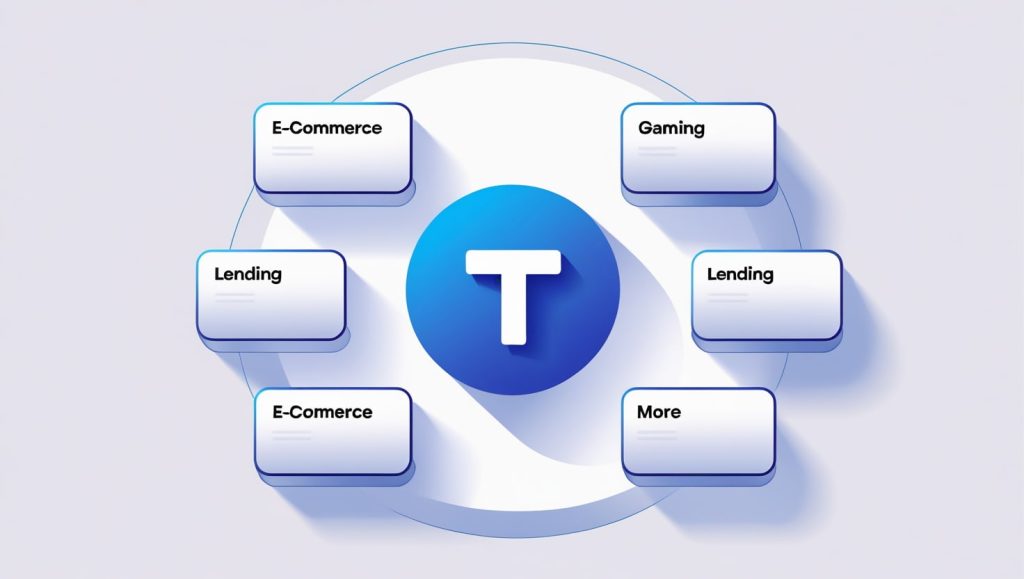As of 2025, Tether (USDT), the leading stablecoin pegged to the US dollar, has become a transformative force in the global economy. Its stability, low transaction fees, and rapid settlement times have made it a preferred payment solution across various industries beyond its well-known role in forex trading. This article explores the top industries adopting Tether, highlighting its use cases, benefits, and future potential. By examining Tether use cases and stablecoin adoption trends, we aim to provide a comprehensive overview of how USDT is reshaping payments in crypto-friendly industries.
|
Industry |
Tether Use Case |
Key Benefits |
Examples/Platforms |
|---|---|---|---|
|
E-commerce |
Online payments for goods |
Low fees, global reach, fast transactions |
NowPayments, 0xProcessing, Shopify |
|
Gaming |
In-game purchases, virtual goods |
Anonymity, speed, global accessibility |
Loot.Bet, G2A Pay |
|
Travel |
Booking hotels, flights, activities |
No currency conversion, fast confirmations |
Travala |
|
Real Estate |
Property transactions |
Stability for large deals, global access |
Propy, Smart Realty |
|
Retail |
Online and physical store payments |
Convenience, potential discounts |
Cryptwerk-listed retailers |
|
Digital Goods |
NFTs, software, subscriptions |
Stability for digital purchases |
OpenSea, NOWPayments |
|
Logistics |
Cross-border supplier payments |
Efficiency, transparency |
ShipChain |
|
Cross-Border Remittances |
International money transfers |
Low-cost, near-instant settlements |
BitPesa, SendFriend |
Understanding Tether (USDT)
Tether, launched in 2014 by Tether Limited, is a stablecoin designed to maintain a 1:1 peg with the US dollar. Each USDT token is backed by reserves, including fiat currency and other assets, ensuring its value remains stable. With a market capitalization exceeding $124 billion and over 350 million users worldwide as of 2024, Tether dominates the stablecoin market, holding a 70% share of trading volume among stablecoins (Tether Wikipedia). While initially used to facilitate cryptocurrency trading, Tether’s utility has expanded into diverse blockchain-based industries, driven by its reliability and efficiency.
Also Read : Top Stablecoins for B2B Payments Gateway in 2025
Benefits of Tether for Payments
Tether’s adoption in various sectors is fueled by several key advantages:
-
Stability: Pegged to the US dollar, Tether minimizes the volatility risks associated with other cryptocurrencies, making it ideal for transactions requiring consistent value.
-
Low Transaction Fees: Tether-based settlements often incur lower fees than traditional banking methods, especially for international payments.
-
Fast Settlement Times: Blockchain technology enables near-instant transactions, reducing delays compared to bank transfers.
-
Global Accessibility: Tether can be used anywhere with an internet connection, bypassing traditional banking infrastructure.
-
Pseudonymity: Transactions with Tether offer a level of privacy, as only wallet addresses are shared, unlike bank details (Techopedia).
These benefits have driven Tether adoption trends across industries, as businesses seek efficient and cost-effective USDT payment solutions.
Top Industries Using Tether
1. E-commerce
The e-commerce sector has embraced e-commerce payments with Tether, leveraging its global reach and cost efficiency. Online retailers use crypto payment gateways like NowPayments (NowPayments) and 0xProcessing (0xProcessing) to integrate USDT payments, enabling seamless transactions for international customers.
-
Global Market Access: Tether allows merchants to serve customers in regions with limited banking access, bypassing currency restrictions.
-
Cost Savings: Retail USDT payments reduce transaction fees compared to credit cards or bank transfers, increasing profit margins.
-
Speed: Fast transaction processing improves customer experience and cash flow.
For example, platforms like Shopify support cryptocurrency payments through gateways, allowing merchants to accept USDT for a wide range of products, from electronics to clothing.
2. Gaming and Entertainment
The gaming industry has seen significant gaming and Tether transactions, particularly for in-game purchases and virtual goods. Blockchain applications in industries like gaming make Tether a natural fit due to its integration with blockchain-based platforms.
-
In-Game Purchases: Players use USDT to buy skins, items, or subscriptions, benefiting from low fees and fast transactions.
-
Global Accessibility: Tether enables players from different countries to make purchases without currency conversion.
-
Anonymity and Security: Cryptocurrency payments offer greater privacy, appealing to gamers concerned about data security.
Platforms like Loot.Bet and G2A Pay (0xProcessing) allow gamers to use USDT, enhancing the gaming experience with seamless transactions.
Also Read : Real-World Use Cases for Tether Gateway Payments
3. Travel and Hospitality
Travel agencies accepting stablecoins are on the rise, with Tether being a popular choice for booking platforms. The travel industry benefits from Tether’s ability to simplify international payments.
-
No Currency Conversion: Travelers can pay with USDT without incurring exchange fees, making it cost-effective for international bookings.
-
Fast Confirmations: Tether transaction volume supports quick booking confirmations, ideal for last-minute travel plans.
Travala, a leading travel booking platform, accepts USDT for booking hotels, flights, and activities (NowPayments). This adoption enhances convenience for crypto-savvy travelers.
4. Real Estate
The real estate sector is exploring real estate crypto payments, with Tether emerging as a viable option for property transactions. While still in its early stages, the stability of USDT makes it attractive for high-value deals.
-
Large Transactions: Tether’s stability ensures secure payments for significant investments like property purchases.
-
Global Market: USDT simplifies cross-border real estate transactions, avoiding banking delays and fees.
Platforms like Propy are experimenting with cryptocurrency payments, including Tether, to streamline property deals (Cryptwerk). As regulatory frameworks evolve, Tether’s role in real estate is likely to grow.
5. Retail
Both online and physical retail stores are adopting retail USDT payments, catering to customers who prefer cryptocurrency.
-
Convenience: Paying with USDT is as simple as scanning a QR code, streamlining the checkout process.
-
Incentives: Retailers may offer discounts for crypto payments, encouraging adoption.
Cryptwerk lists over 1,900 businesses, including retail stores, accepting USDT (Cryptwerk). For example, some electronics and fashion retailers now accept Tether, enhancing payment flexibility.
6. Digital Goods and Services
The market for digital goods payment with Tether is thriving, particularly for non-fungible tokens (NFTs), software, and subscription-based services using crypto.
-
NFTs: Tether’s stability makes it a preferred currency for NFT purchases on platforms like OpenSea.
-
Subscriptions: Online services, such as SaaS platforms, accept USDT for recurring payments, offering users more options.
NOWPayments supports Tether payments for digital services, enabling creators and consumers to engage in the digital economy (NOWPayments).
7. Logistics and Supply Chain
Blockchain logistics payments are gaining traction, with Tether being used for cross-border shipments and supply chain transactions.
-
Efficiency: USDT enables fast payments to international suppliers, reducing costs and delays.
-
Transparency: Blockchain ensures transparent tracking of payments, enhancing trust in complex supply chains.
While adoption is still emerging, companies like ShipChain are exploring Tether for logistics payments, leveraging its efficiency (0xProcessing).
Also Read : Tether Gateway Payment for Prop Trading Firms
8. Cross-Border Remittances
Cross-border remittances with stablecoins are one of Tether’s most impactful applications. Traditional remittance methods are slow and costly, but Tether offers a faster, cheaper alternative.
-
Cost Savings: Low fees make USDT ideal for migrant workers sending money home.
-
Speed: Near-instant settlements ensure recipients access funds quickly.
Services like BitPesa and SendFriend use Tether to facilitate remittances, impacting millions globally (Techopedia).
Challenges and Considerations
Despite its benefits, Tether’s adoption faces challenges:
-
Regulatory Uncertainty: The legal status of cryptocurrencies varies by country, affecting businesses’ ability to accept USDT (Ledger Insights).
-
Security Risks: While blockchain is secure, users must use reputable wallets to avoid scams.
-
Transparency Concerns: Tether has faced criticism over the transparency of its reserves, with past investigations raising questions about its backing (The Verge).
These challenges are being addressed through improved regulations and security measures, paving the way for broader adoption.
Future Trends in Tether Adoption
The future of Tether looks promising, with several trends driving its growth:
-
Expanding Acceptance: As more businesses recognize the benefits of crypto payment gateways, Tether’s adoption will increase.
-
Technological Advancements: Improvements in blockchain technology will make USDT integration easier.
-
New Industries: Sectors like healthcare and education may explore Tether for payments, following the lead of early adopters.
Tether’s recent ventures into AI and commodity trade finance suggest its potential to diversify further (Ledger Insights).
Conclusion
Tether (USDT) has evolved from a forex trading tool to a versatile payment solution across crypto-friendly industries. Its stability, low fees, and fast transactions make it ideal for e-commerce, gaming, travel, real estate, retail, digital goods, logistics, and remittances. While challenges like regulatory uncertainty and transparency concerns persist, Tether’s growing Tether transaction volume and adoption trends indicate a bright future. Businesses and consumers alike can leverage USDT payment solutions to navigate the evolving financial landscape, fostering a more inclusive and efficient global economy.








